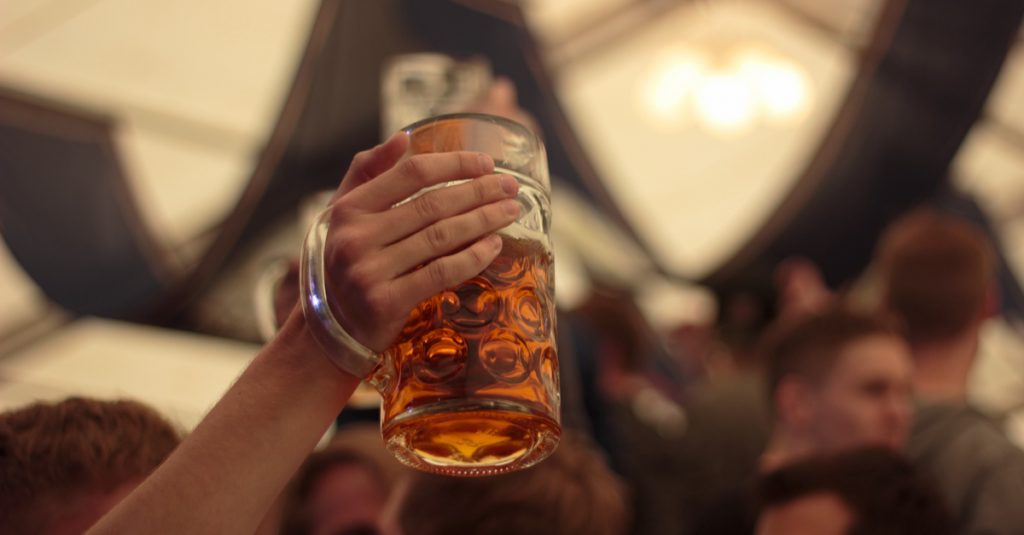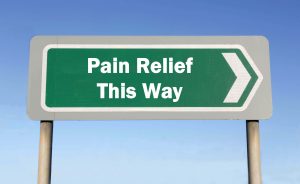Can alcohol make pain worse?

 Most of us like a drink at some point, whether it is to relax at the weekend, socialize with friends, or complement a meal, but did you know that alcohol has a complex relationship with pain? We all know that alcohol can dull pain at the time of drinking it, but regular ingestion of alcohol can have less predictable effects on your pain levels depending on how much you drink. In this article, we seek to explain alcohol’s rather odd relationship with pain.
Most of us like a drink at some point, whether it is to relax at the weekend, socialize with friends, or complement a meal, but did you know that alcohol has a complex relationship with pain? We all know that alcohol can dull pain at the time of drinking it, but regular ingestion of alcohol can have less predictable effects on your pain levels depending on how much you drink. In this article, we seek to explain alcohol’s rather odd relationship with pain.
One of the more common responses to the question we ask of patients ‘what helps relieve your pain?’ is ‘wine!’ so it will not be news to many of you that alcohol has a painkilling effect. There have been many studies that show that drinking alcohol can increase your tolerance to electrical stimulation pain and mechanical pressure pain (1). One of the reasons this may happen is that alcohol stimulates the body to release the painkilling chemicals known as opioids, this effects and reduces your perception of pain. (2). Also, if you have previously drank alcohol when you had pain and experienced that it helped reduce your pain then you are more likely to report less perceived pain when drinking alcohol again, this may lead to a more transmitted belief in society that alcohol will help with pain potentiating its effect (3).
Can Drinking Heavily Actually Cause Pain?
 The answer here is yes. Repeated chronic alcohol use can result in several painful conditions such as pancreatitis, 60-90% of cases of chronic pancreatitis are directly related to the heavy use of alcohol (4). Also, as alcohol has a toxic effect on the nervous system people who drink heavily over a long period can suffer damage to their sensory nerves leading to alcohol-related neuropathy, the early stages of which is characterized by the presence of chronic pain (5).
The answer here is yes. Repeated chronic alcohol use can result in several painful conditions such as pancreatitis, 60-90% of cases of chronic pancreatitis are directly related to the heavy use of alcohol (4). Also, as alcohol has a toxic effect on the nervous system people who drink heavily over a long period can suffer damage to their sensory nerves leading to alcohol-related neuropathy, the early stages of which is characterized by the presence of chronic pain (5).
The examples above are not too surprising, most people would assume that heavy prolonged alcohol use would cause severe illness, but excessive alcohol consumption is also a contributory factor to other painful conditions;
• Osteoarthritis – a study in 2000 found that men who consume more than 14 drinks a week were more likely to develop osteoarthritis (6).
• Knee pain – people who drank alcohol every day were associated with having an increased likelihood of having recurring knee pain (7).
• Chronic pain after trauma – There is quite a bit of evidence that people who drink over two drinks a day following a lower limb trauma were 20% more likely to develop chronic ongoing pain after the trauma has healed (8).
One possible reason that is cited for the effect of heavy alcohol on pain levels is that alcohol’s initial stimulation of the release of opioids into the body eventually becomes disorganized and results in a deficiency in the opioid system. This means that for heavy drinkers the normal level in the body of these painkilling chemicals is lowered resulting in a higher level of pain in general (9).
What effect does moderate drinking have on pain?
This is where it gets interesting, whereas heavy alcohol use can contribute to increased pain levels, moderate or low alcohol use has been found to be protective from pain in some cases. Several well-designed studies that have controlled for other factors have indicated that low to moderate alcohol usage can reduce the likelihood of a person developing chronic pain (1).
More specifically researchers have found that compared to non-drinkers moderate drinkers are;
• 80% less likely to develop chronic widespread pain (10).
• 25% less likely to develop persistent low back pain (11).
• 40-70% less likely to develop disabling chronic low back or neck pain (12)
• Less likely to develop recurrent pain that lasts over 6 months (13).
 Moderate alcohol drinkers who currently suffer from chronic pain also report better pain outcomes when compared to non-drinkers such as less intensity of pain, better physical functioning, improved quality of life, and fewer missed days from work (1).
Moderate alcohol drinkers who currently suffer from chronic pain also report better pain outcomes when compared to non-drinkers such as less intensity of pain, better physical functioning, improved quality of life, and fewer missed days from work (1).
The effect of moderate drinking on pain may be due to a couple of factors that are synonymous with chronic pain. Fear of movement and movement avoidance is a feature of chronic pain and is an important factor in how chronic pain is developed and maintained. The moderate intake of alcohol may result in disinhibition and reduction the movement avoidance patterning which then affects the reported pain levels (14). Moderate drinkers report that social interaction is a motive for drinking alcohol and alcohol has been shown to facilitate social bonding (15). Chronic pain is associated with social isolation, therefore chronic pain sufferers may drink to engage in social experiences and report better quality of life (16).
As you can see alcohol and pain have a rather unexpected relationship. As alcohol is essentially a toxin you would have expected that any usage would be bad but in the case of pain, the evidence shows that light to moderate drinking may actually help with the likelihood of developing chronic pain and reducing the debilitating effect of having chronic pain. A fun fact to be aware of when discussing this subject is that 40% of all trauma admissions to orthopaedic wards in hospitals are intoxicated with alcohol, so do be careful (17)!
Do you want to know what is causing your pain and if we can help? Why not take advantage of our new patient assessment introductory offer to get you started towards a tailor made recovery plan for only £19.
Are you in a lot of pain and want to get better as soon as possible? If so then why not book in for a new patient consultation, with treatment on the day, for £75.
References
1 – Zale EL, Maisto SA, Ditre JW. Interrelations between pain and alcohol: An integrative review. Clin Psychol Rev. 2015 Apr;37:57-71.
2 – Campbell VC, Taylor RE, Tizabi Y. Effects of selective opioid receptor antagonists on alcohol-induced and nicotine-induced antinociception. Alcoholism, Clinical and Experimental Research. 2007;31:1435–1440
3 – Pollo A, Amanzio M, Arslanian A, Casadio C, Maggi G, Benedetti F. Response expectancies in placebo analgesia and their clinical relevance. Pain. 2001;93:77–84.
4 – Dufour MC, Adamson MD. The epidemiology of alcohol-induced pancreatitis. Pancreas. 2003;27:286–290.
5 – Chopra K, Tiwari V. Alcoholic neuropathy: possible mechanisms and future treatment possibilities. British Journal of Clinical Pharmacology. 2012;73:348–362.
6 – Cheng Y, Macera CA, Davis DR, Ainsworth BE, Troped PJ, Blair SN. Physical activity and self-reported, physician-diagnosed osteoarthritis: is physical activity a risk factor? Journal of Clinical Epidemiology. 2000;53:315–322.
7 – Sa KN, Baptista AF, Matos MA, Lessa I. Chronic pain and gender in Salvador population, Brazil. Pain. 2008;139:498–506.
8 – Castillo RC, MacKenzie EJ, Wegener ST, Bosse MJ, Group LS. Prevalence of chronic pain seven years following limb threatening lower extremity trauma. Pain. 2006;124:321–329.
9 – Gianoulakis C. Influence of the endogenous opioid system on high alcohol consumption and genetic predisposition to alcoholism. Journal of Psychiatry and Neuroscience. 2001;26:304–318.
10 – Ang DC, Peloso PM, Woolson RF, Kroenke K, Doebbeling BN. Predictors of incident chronic widespread pain among veterans following the first Gulf War. Clinical Journal of Pain. 2006;22:554–563.
11 – Hestbaek L, Leboeuf-Yde C, Kyvik KO. Are lifestyle-factors in adolescence predictors for adult low back pain? A cross-sectional and prospective study of young twins. BMC Musculoskeletal Disorders. 2006;7:27
12 – Skillgate E, Vingard E, Josephson M, Holm LW, Alfredsson L. Is smoking and alcohol consumption associated with long-term sick leave due to unspecific back or neck pain among employees in the public sector? Results of a three-year follow-up cohort study. Journal of Rehabilitation Medicine. 2009;41:550–556.
13 – Sá KN, de Mesquita Pereira C, Souza RC, Baptista AF, Lessa I. Knee Pain Prevalence and Associated Factors in a Brazilian Population Study. Pain Medicine. 2011;12:394–402.
14 – Booker EA, Haig AJ, Geisser ME, Yamakawa K. Alcohol use self report in chronic back pain–relationships to psychosocial factors, function performance, and medication use. Disability and Rehabilitation. 2003;25:1271–1277.
15 – Sayette MA, Creswell KG, Dimoff JD, Fairbairn CE, Cohn JF, Heckman BW, Moreland RL. Alcohol and group formation: a multimodal investigation of the effects of alcohol on emotion and social bonding. Psychological Science. 2012;23:869–878.
16 – Kim CH, Vincent A, Clauw DJ, Luedtke CA, Thompson JM, Schneekloth TD, Oh TH. Association between alcohol consumption and symptom severity and quality of life in patients with fibromyalgia. Arthritis Research & Therapy. 2013;15:R42.
17 – Levy RS, Hebert CK, Munn BG, Barrack RL. Drug and alcohol use in orthopedic trauma patients: a prospective study. J Orthop Trauma. 1996;10:21–27

